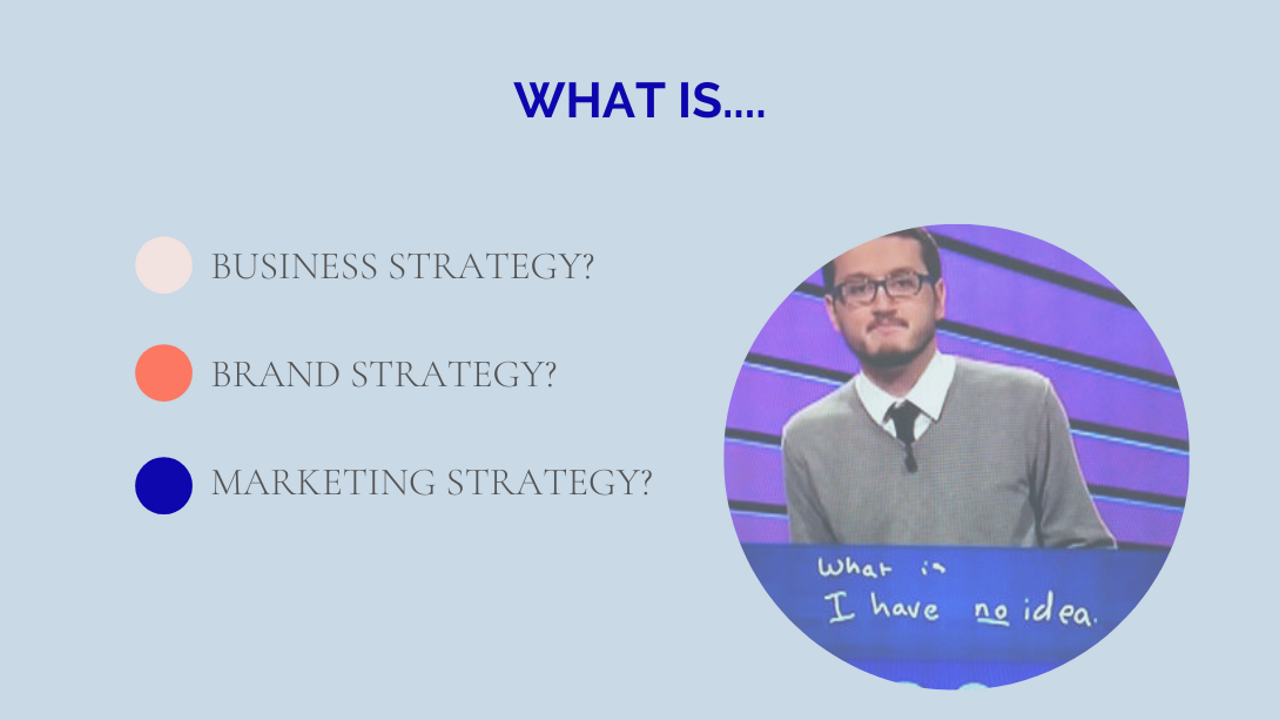Business strategy, brand strategy and marketing strategy - what's the difference?

Jargon and definitions can make marketing and branding feel impossible to learn. I'm on a mission to make things clearer! In this blog I clear up:
What is a marketing strategy?
What’s the difference between marketing strategy and brand strategy?
What’s the difference between brand strategy and business strategy?
And what’s the answer to the ultimate question of life, the universe, and everything??? (Well, we know that’s 42. Read on for the rest).
What is business strategy vs. brand strategy vs. marketing strategy?
Business strategy identifies where an organisation wants to go.
It usually includes a hard metric vision or goal like, 'to be a $10 billion business by 2025', or 'to grow by 35% in the next 5 years'. It also includes the operational changes required to help to get there.
Brand strategy is really about why people should care. Because the only way an organisation can achieve their business strategy is through people – more people buying their product or service, and the right people employed to connect these customers with the products and services.
Brand strategy outlines WHY the company exists (obviously rooted in an idea that is compelling to the people the business needs to attract); WHO employees are and need to be to deliver on this idea (encapsulating a definition of culture/values/behaviours); HOW the brand should look, feel and sound: and WHAT it is that the business actually does.
Marketing strategy is your action plan for reaching the people who should be interested in your product or service and turning them into customers.
(In my mind, a marketing strategy should also be about how to reach the prospective recruits that the company needs to hire to deliver on the brand and business strategy. But because the responsibility for this typically sits with HR, not marketing, this instead becomes part of the awful term, ‘employer branding.’ But I digress....)
Mark Ritson’s article published yesterday, Planning for marketing planning: 14 steps to a marketing presentation, is a fantastic guide to writing a marketing strategy, if that’s something on your plate this month.
A new marketing strategy is typically written every 12 months, and the tactics employed to action the strategy often change, based on consumer profiling, data and measures you put in place, channels you use, campaign analysis, trends, etc.
Brand strategy, however, when done well, can last decades, outlasting both marketing and business strategy. And if it’s properly embraced by the organisation, brand strategy eventually becomes a key driver of business strategy.
How does brand strategy influence business strategy?
Nine years ago, a study was instigated to look at the three strategies known to drive high growth in companies - creating new markets, serving broader stakeholder needs, and rewriting the rules of the game. But in conducting the study the authors discovered a fourth driver they hadn’t considered at all: purpose: the answer to WHY that forms the heart of any brand strategy.
In the Harvard Business Review article, ‘Put Purpose at the Core of Your Strategy' by Thomas Malnight, Ivy Bucke and Charles Dhanaraj, the authors share case studies from some of the high growth companies they studied, identifying how the brand purpose inspired significant changes to the business strategies that ultimately contributed to the high growth of the organisation.
Take Mars Petcare, who defined their purpose as, “A better world for pets.” Because of this, they began acquiring veterinary services: BluePearl in 2015 and VCA in 2017. Then in 2018, further veterinary acquisitions expanded their reach into 8 European countries. Those acquisitions helped Mars Petcare become Mars Inc.’s largest and fastest-growing business division.
In 2016 the company also acquired Whistle, the San Francisco–based maker of a connected collar for activity monitoring and location tracking—a kind of Fitbit for dogs. This has led to them embarking (ho, ho) on a three-year longitudinal study among 200,000 US dogs called the Pet Insight Project, that combines machine learning, data science, and deep veterinary expertise, in order to understand when behaviour may signal a change in a pet’s health and how owners can partner with their veterinarians on individualized diagnostics and treatments for their pets.
So, getting a strong brand strategy in place, with a guiding purpose of 'A better world for pets', promoted them to shift their business strategy from a narrower focus on pet food to a swathe of pet health products and services.
Another great example is Sweden’s Securitas AB, a security company with 370,000 employees, that traditionally offered physical security guard services. But with their purpose of “contributing to a safer society,” as a guide, their business strategy shifted into electronic security and then risk management services. This contributed to sustained high business growth and diversification of their revenue sources. For example, from 2012 to 2018 the company’s sales of security solutions and electronic security went from 6% of total revenue to 20%.
Before a business has a brand strategy in place, they are missing a critical cog in their machine. But once they get a good one, not only is their marketing strategy tighter since it's ultimately focused on building the associations in the brand strategy, but business growth through innovation, and motivation, is more focused and inspired.
So business strategy, brand strategy and marketing strategy are all different, but need to be integrated. And when companies truly embrace their brand strategy, their business and marketing strategy gets stronger. Win, win, win.
Get brand strategy smarter in 5 minutes a week
Join our weekly newsletter. No fluff. Sent Fridays.
By clicking the button, you agree to receive the 'Brand Strategy Smarter' newsletter and marketing emails from Brand Strategy Sarah about our products and services. Unsubscribe at any time.


